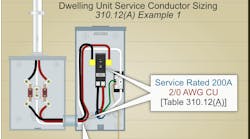In this episode of “EC&M Tech Talks,” Randy Barnett, a journeyman electrician, inspector, author, trainer, and electrical safety expert, discusses electrical safety when working with medium-voltage systems.
Larger industrial and manufacturing facilities as well as campus-style facilities often distribute power at voltages up to 15,000V (15kV) within the facilities. No matter the voltage level, the basic electrical safety rules found in the NFPA 70E, Standard for Electrical Safety in the Workplace, still apply. Depending on the voltage level, the changes include certain shock boundary distances and the tools necessary to verify an electrically safe work condition. For example, the correct rubber insulating glove class must be selected and live-line tools must be inspected. Non-contact voltage detectors are used to check for voltage and temporary personal protective grounds are installed to verify an electrically safe work condition.
In this Tech Talk, Randy begins with a discussion of the risk assessment process for working with medium-voltage systems. Limited and restricted approach boundary numbers found on arc flash warning labels are presented, and their significance is explained. PPE inspections are demonstrated for both Class II rubber insulating gloves and a 40 cal/cm2 arc flash suit. A “hot stick” and grounding clamp are used to discuss temporary protective grounding. He explains the placement of the barricade and reviews the six items for normal operation of equipment.
Overall, the basic concepts of working safely with electricity do not change from lower to medium voltages. Begin with a documented risk assessment, and analyze each step involved in the job. Select, inspect, and properly don the appropriate PPE. Set up a barricade at the larger distance of the limited approach or arc flash boundary. Be sure to inspect the proper tools and test equipment, including temporary protective grounds, and follow all electrical safe work practices.



